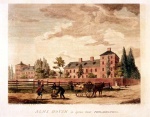Difference between revisions of "Portal:Featured Article Of The Week"
M-Explorer (talk | contribs) |
M-Explorer (talk | contribs) (I didn't see that Soldat added to the future list so I decided to revert my earlier additon for Soldat's nomination.) |
||
| Line 1: | Line 1: | ||
{{FAformat | {{FAformat | ||
| − | |Title= | + | |Title= Blockley Almshouse |
| − | |Image= | + | |Image= Spruce Street Almshouse.jpg |
|Width= 150px | |Width= 150px | ||
| − | |Body= | + | |Body= With the Frind's Almshouse operating since 1713 the city put off construction of it's own facilities until 1732, and the Philadelphia Almshouse was established. Occupying the entire block between Third and Fourth, Spruce and Pine Streets this was the first government funded poorhouse in the United States and was regarded as a model institution, it had separate facilities for the indigent and the insane, and also an infirmary. In 1767, the much larger alms house with an infirmary, and the house of workhouse were completed on the south side of Spruce Street between Tenth and Eleventh. By 1830, overcrowding necessitated further expansion, and a new alms house for men and another for women, a separate hospital and a workhouse were built, 1827-1832. This included departments for children as well as a colored department. This complex was built across the Schuylkill River in Blockley Township, in what is now University City in West Philadelphia. William Strickland was the architect and Samuel Sloan, later to be a well-known architect, worked as journeyman carpenter on the project. This facility soon became known as "Old Bockley". Operated by a city committee known as the Guardians of the Poor, Blockley’s early reputation for care was dismal. In 1864, the "Female Lunatic Asylum" building was accidentally destroyed by workers installing heaters, killing 18 women and injuring another 20. Article on Fire By 1885 there had been four fires at the institution. Blockley's geographical isolation from city medical institutions limited clinical care until the University of Pennsylvania, with its medical school, moved to a new site just north of the Almshouse grounds in 1871. |
| − | + | Despite the huge size of the institution for its time, with the ability to accommodate about 3,000, by 1870 it was overcrowded with a population of 3,789. According to the 1878 Annual report of the Board of Commissioners of Public Charities Blockley's Insane department housed 1,200, accounting for a full quarter of all insane in the state. In order to address this overcrowding at Blockley the state built the State Asylum for the Insane at Norristown, opening in 1880.[[Blockley Almshouse|Click here for more...]] | |
| − | |||
| − | |||
}} | }} | ||
Revision as of 03:33, 18 April 2011
Featured Article Of The Week
Blockley Almshouse
With the Frind's Almshouse operating since 1713 the city put off construction of it's own facilities until 1732, and the Philadelphia Almshouse was established. Occupying the entire block between Third and Fourth, Spruce and Pine Streets this was the first government funded poorhouse in the United States and was regarded as a model institution, it had separate facilities for the indigent and the insane, and also an infirmary. In 1767, the much larger alms house with an infirmary, and the house of workhouse were completed on the south side of Spruce Street between Tenth and Eleventh. By 1830, overcrowding necessitated further expansion, and a new alms house for men and another for women, a separate hospital and a workhouse were built, 1827-1832. This included departments for children as well as a colored department. This complex was built across the Schuylkill River in Blockley Township, in what is now University City in West Philadelphia. William Strickland was the architect and Samuel Sloan, later to be a well-known architect, worked as journeyman carpenter on the project. This facility soon became known as "Old Bockley". Operated by a city committee known as the Guardians of the Poor, Blockley’s early reputation for care was dismal. In 1864, the "Female Lunatic Asylum" building was accidentally destroyed by workers installing heaters, killing 18 women and injuring another 20. Article on Fire By 1885 there had been four fires at the institution. Blockley's geographical isolation from city medical institutions limited clinical care until the University of Pennsylvania, with its medical school, moved to a new site just north of the Almshouse grounds in 1871.
Despite the huge size of the institution for its time, with the ability to accommodate about 3,000, by 1870 it was overcrowded with a population of 3,789. According to the 1878 Annual report of the Board of Commissioners of Public Charities Blockley's Insane department housed 1,200, accounting for a full quarter of all insane in the state. In order to address this overcrowding at Blockley the state built the State Asylum for the Insane at Norristown, opening in 1880.Click here for more...
